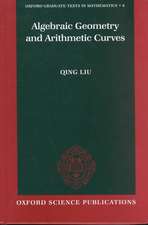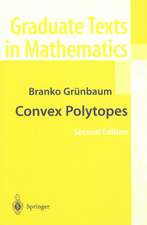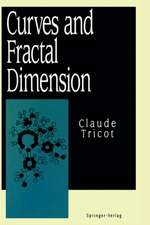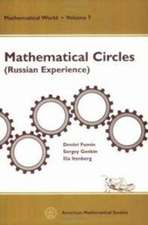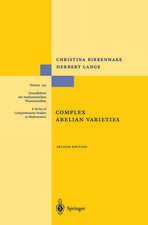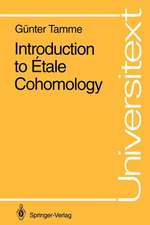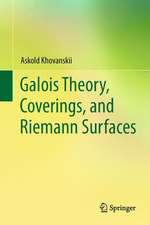Real Algebraic Geometry: UNITEXT, cartea 66
Autor Vladimir I. Arnold Editat de Ilia Itenberg, Viatcheslav Kharlamov, Eugenii I. Shustin Traducere de Gerald G. Goulden Limba Engleză Paperback – 3 mai 2013
At one of the first international mathematical congresses (in Paris in 1900), Hilbert stated a special case of this question in the form of his 16th problem (from his list of 23 problems left over from the nineteenth century as a legacy for the twentieth century).
In spite of the simplicity and importance of this problem (including its numerous applications), it remains unsolved to this day (although, as you will now see, many remarkable results have been discovered).
Din seria UNITEXT
-
 Preț: 458.61 lei
Preț: 458.61 lei - 17%
 Preț: 402.50 lei
Preț: 402.50 lei -
 Preț: 403.82 lei
Preț: 403.82 lei -
 Preț: 434.06 lei
Preț: 434.06 lei - 20%
 Preț: 571.54 lei
Preț: 571.54 lei -
 Preț: 277.32 lei
Preț: 277.32 lei - 13%
 Preț: 427.17 lei
Preț: 427.17 lei -
 Preț: 335.81 lei
Preț: 335.81 lei -
 Preț: 283.76 lei
Preț: 283.76 lei -
 Preț: 271.54 lei
Preț: 271.54 lei -
 Preț: 361.12 lei
Preț: 361.12 lei -
 Preț: 221.27 lei
Preț: 221.27 lei -
 Preț: 345.56 lei
Preț: 345.56 lei -
 Preț: 455.00 lei
Preț: 455.00 lei -
 Preț: 393.99 lei
Preț: 393.99 lei -
 Preț: 459.92 lei
Preț: 459.92 lei - 17%
 Preț: 364.75 lei
Preț: 364.75 lei -
 Preț: 365.15 lei
Preț: 365.15 lei - 17%
 Preț: 363.85 lei
Preț: 363.85 lei -
 Preț: 329.06 lei
Preț: 329.06 lei -
 Preț: 358.93 lei
Preț: 358.93 lei -
 Preț: 352.80 lei
Preț: 352.80 lei -
 Preț: 348.27 lei
Preț: 348.27 lei -
 Preț: 242.17 lei
Preț: 242.17 lei - 15%
 Preț: 789.30 lei
Preț: 789.30 lei -
 Preț: 295.90 lei
Preț: 295.90 lei - 15%
 Preț: 560.69 lei
Preț: 560.69 lei -
 Preț: 426.72 lei
Preț: 426.72 lei -
 Preț: 450.33 lei
Preț: 450.33 lei -
 Preț: 357.43 lei
Preț: 357.43 lei - 17%
 Preț: 361.97 lei
Preț: 361.97 lei -
 Preț: 551.87 lei
Preț: 551.87 lei -
 Preț: 414.65 lei
Preț: 414.65 lei -
 Preț: 221.87 lei
Preț: 221.87 lei -
 Preț: 460.91 lei
Preț: 460.91 lei -
 Preț: 434.34 lei
Preț: 434.34 lei -
 Preț: 263.28 lei
Preț: 263.28 lei -
 Preț: 192.44 lei
Preț: 192.44 lei -
 Preț: 379.48 lei
Preț: 379.48 lei -
 Preț: 497.96 lei
Preț: 497.96 lei -
 Preț: 240.26 lei
Preț: 240.26 lei -
 Preț: 381.98 lei
Preț: 381.98 lei -
 Preț: 326.72 lei
Preț: 326.72 lei -
 Preț: 432.58 lei
Preț: 432.58 lei -
 Preț: 325.20 lei
Preț: 325.20 lei -
 Preț: 269.60 lei
Preț: 269.60 lei -
 Preț: 496.35 lei
Preț: 496.35 lei -
 Preț: 329.83 lei
Preț: 329.83 lei -
 Preț: 249.89 lei
Preț: 249.89 lei -
 Preț: 364.56 lei
Preț: 364.56 lei
Preț: 411.16 lei
Nou
Puncte Express: 617
Preț estimativ în valută:
78.67€ • 82.15$ • 64.97£
78.67€ • 82.15$ • 64.97£
Carte tipărită la comandă
Livrare economică 15-29 aprilie
Preluare comenzi: 021 569.72.76
Specificații
ISBN-13: 9783642362422
ISBN-10: 3642362427
Pagini: 120
Ilustrații: IX, 100 p. 126 illus.
Dimensiuni: 155 x 235 x 17 mm
Greutate: 0.18 kg
Ediția:2013
Editura: Springer Berlin, Heidelberg
Colecția Springer
Seriile UNITEXT, La Matematica per il 3+2
Locul publicării:Berlin, Heidelberg, Germany
ISBN-10: 3642362427
Pagini: 120
Ilustrații: IX, 100 p. 126 illus.
Dimensiuni: 155 x 235 x 17 mm
Greutate: 0.18 kg
Ediția:2013
Editura: Springer Berlin, Heidelberg
Colecția Springer
Seriile UNITEXT, La Matematica per il 3+2
Locul publicării:Berlin, Heidelberg, Germany
Public țintă
Lower undergraduateCuprins
Publisher's Foreword.- Editors' Foreword.- Introduction.- 2 Geometry of Conic Sections.- 3 The Physics of Conic Sections and Ellipsoids.- 4 Projective Geometry.- 5 Complex Algebraic Curves.- 6 A Problem for School Pupils.- A Into How Many Parts do n Lines Divide the Plane?- Editors' Comments on Gudkov's Conjecture.- Notes
Recenzii
From the reviews:
“As Arnold’s own 1971 contribution altered the direction of research on this question, this book constitutes a summary of the story coming directly from the master. Summing Up: Recommended. Upper-division undergraduates through researchers/faculty.” (D. V. Feldman, Choice, Vol. 51 (6), February, 2014)
“This book is a translation of lecture notes from Russian with additional comments and notes by the editors. The book is aimed at advanced high school students … . It introduces very advanced topics in a very relaxed and informal style. The book includes some exposition and definitions, some theorems and proofs and a lot of problems with hints or solutions. There are many illustrations to lead the reader to an intuitive understanding of the concepts being developed.” (Thomas C. Craven, Mathematical Reviews, December, 2013)
“It was designed as a set of lecture notes addressed to mathematically talented high-school students, with the main focus on a panoramic view toward elementary, problems concerning geometric objects that can be described by (mostly real) algebraic equations. … this is a highly unusual book on real algebraic curves and various related topics. … a truly irresistible invitation to mathematics in general.” (Werner Kleinert, zbMATH, Vol. 1268, 2013)
“As Arnold’s own 1971 contribution altered the direction of research on this question, this book constitutes a summary of the story coming directly from the master. Summing Up: Recommended. Upper-division undergraduates through researchers/faculty.” (D. V. Feldman, Choice, Vol. 51 (6), February, 2014)
“This book is a translation of lecture notes from Russian with additional comments and notes by the editors. The book is aimed at advanced high school students … . It introduces very advanced topics in a very relaxed and informal style. The book includes some exposition and definitions, some theorems and proofs and a lot of problems with hints or solutions. There are many illustrations to lead the reader to an intuitive understanding of the concepts being developed.” (Thomas C. Craven, Mathematical Reviews, December, 2013)
“It was designed as a set of lecture notes addressed to mathematically talented high-school students, with the main focus on a panoramic view toward elementary, problems concerning geometric objects that can be described by (mostly real) algebraic equations. … this is a highly unusual book on real algebraic curves and various related topics. … a truly irresistible invitation to mathematics in general.” (Werner Kleinert, zbMATH, Vol. 1268, 2013)
Notă biografică
Vladimir Arnold is one of the great mathematical scientists of our time. He is famous for both the breadth and the depth of his work.
His first mathematical work, which he did being a third-year student, was the solution of the 13th Hilbert problem about superpositions of continuous functions. His early work on KAM (Kolmogorov, Arnold, Moser) theory solved some of the outstanding problems of mechanics that grew out of fundamental questions raised by Poincare and Birkhoff based on the discovery of complex motions in celestial mechanics. In particular, the discovery of invariant tori, their dynamical implications, and attendant resonance phenomena is regarded today as one of the deepest and most significant achievements in the mathematical sciences.
Arnold has been the advisor to more than 60 PhD students, and is famous for his seminar which thrived on his ability to discover new and beautiful problems. He is known all over the world for his textbooks which include the classics Mathematical Methods of Classical Mechanics, and Ordinary Differential Equations, as well as the more recent Topological Methods m Hydrodynamics written together with Boris Khesin, and Lectures on Partial Differential Equations.
His first mathematical work, which he did being a third-year student, was the solution of the 13th Hilbert problem about superpositions of continuous functions. His early work on KAM (Kolmogorov, Arnold, Moser) theory solved some of the outstanding problems of mechanics that grew out of fundamental questions raised by Poincare and Birkhoff based on the discovery of complex motions in celestial mechanics. In particular, the discovery of invariant tori, their dynamical implications, and attendant resonance phenomena is regarded today as one of the deepest and most significant achievements in the mathematical sciences.
Arnold has been the advisor to more than 60 PhD students, and is famous for his seminar which thrived on his ability to discover new and beautiful problems. He is known all over the world for his textbooks which include the classics Mathematical Methods of Classical Mechanics, and Ordinary Differential Equations, as well as the more recent Topological Methods m Hydrodynamics written together with Boris Khesin, and Lectures on Partial Differential Equations.
Textul de pe ultima copertă
This book is concerned with one of the most fundamental questions of mathematics: the relationship between algebraic formulas and geometric images.
At one of the first international mathematical congresses (in Paris in 1900), Hilbert stated a special case of this question in the form of his 16th problem (from his list of 23 problems left over from the nineteenth century as a legacy for the twentieth century).
In spite of the simplicity and importance of this problem (including its numerous applications), it remains unsolved to this day (although, as you will now see, many remarkable results have been discovered).
At one of the first international mathematical congresses (in Paris in 1900), Hilbert stated a special case of this question in the form of his 16th problem (from his list of 23 problems left over from the nineteenth century as a legacy for the twentieth century).
In spite of the simplicity and importance of this problem (including its numerous applications), it remains unsolved to this day (although, as you will now see, many remarkable results have been discovered).
Caracteristici
Written by one of the most eminent mathematicians of the 20th and 21st centuries Masterful exposition Lecture courses do not get better than this Includes supplementary material: sn.pub/extras

